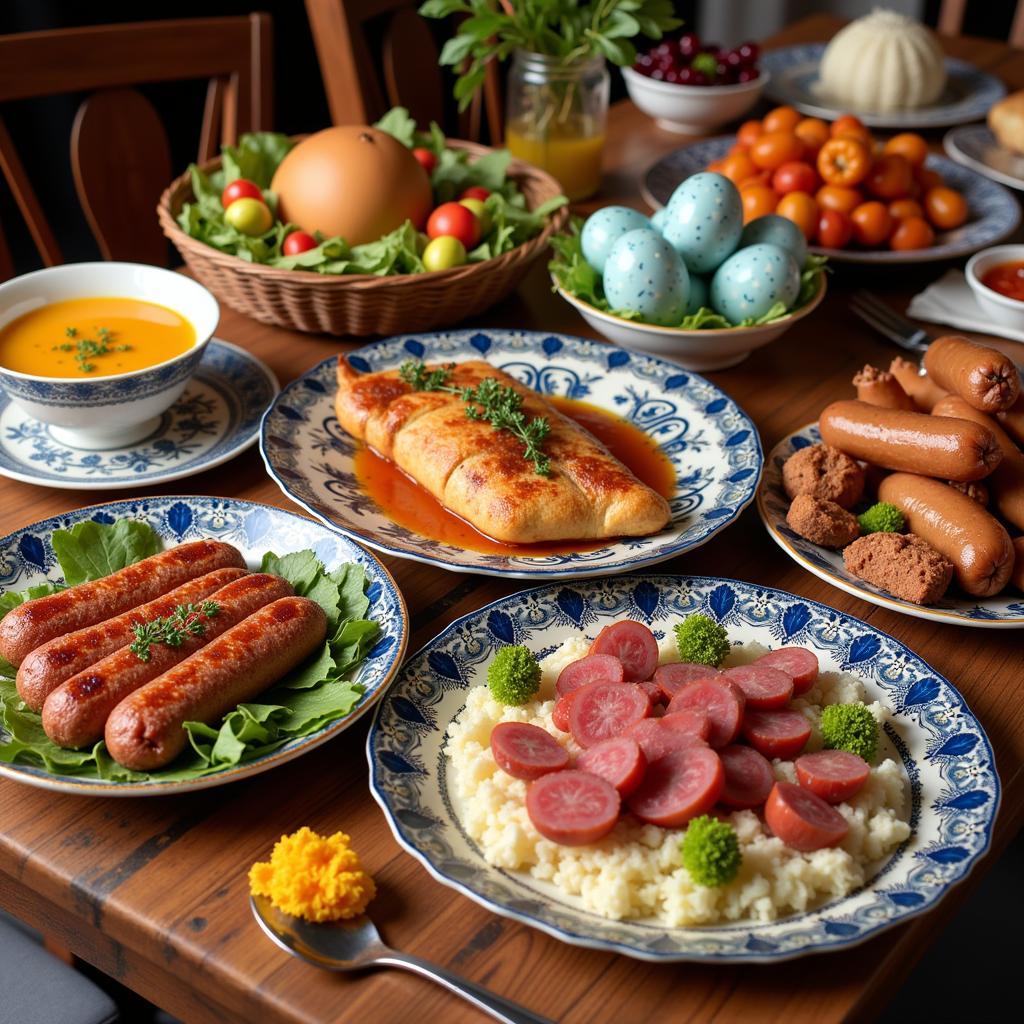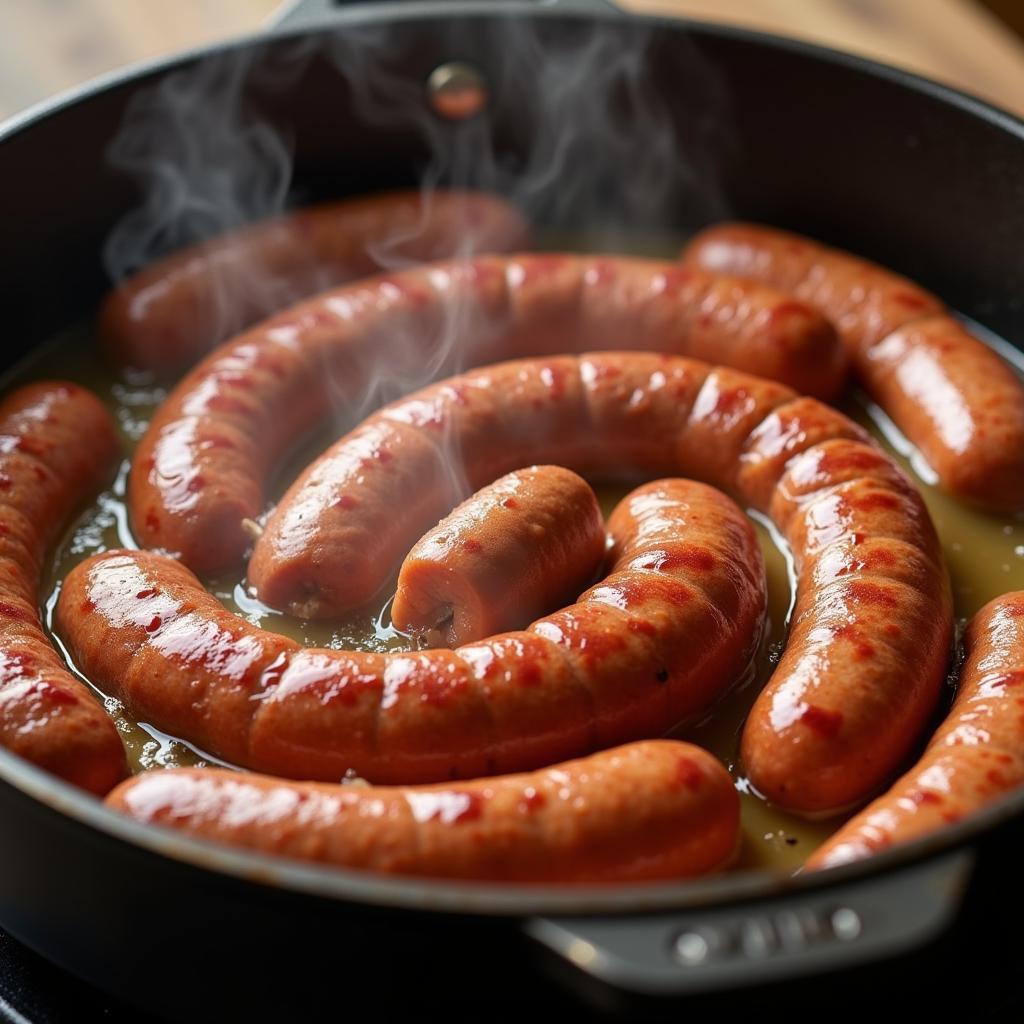Polish Easter Food is a vibrant and symbolic celebration of spring, family, and faith. From the colorful pisanki eggs to the rich żurek soup, every dish tells a story and offers a unique taste of Polish tradition. Let’s explore the delightful world of Polish Easter cuisine and discover the heart of this festive season.  A Colorful Spread of Traditional Polish Easter Dishes
A Colorful Spread of Traditional Polish Easter Dishes
The Significance of Food in Polish Easter Traditions
Easter in Poland is a deeply rooted cultural experience, and food plays a central role. The dishes served aren’t just meant to satisfy hunger; they are symbolic representations of rebirth, renewal, and the end of the Lenten fast. Many of the foods, like eggs and bread, hold religious significance, adding another layer of meaning to the Easter feast. After weeks of abstinence, Polish families gather to enjoy a lavish spread of symbolic dishes, celebrating the joy of Easter Sunday. You can find some of these amazing ingredients through an eastern european food online retailer.
The Symbolic Egg: Pisanki and Beyond
Perhaps the most iconic symbol of Polish Easter is the pisanka, a beautifully decorated egg. These intricate works of art are created using a wax-resist method, resulting in vibrant patterns and colors. Pisanki are more than just decorations; they symbolize new life and are often exchanged as gifts between family and friends. Beyond pisanki, eggs are also incorporated into various Easter dishes, showcasing their versatility and importance in Polish cuisine.
Imagine biting into a fluffy, buttery babka, still warm from the oven. That’s the magic of Polish Easter baking. From the sweet mazurek cake to the airy babka bread, these delightful treats are a testament to Polish baking traditions. Often decorated with colorful icing and dried fruits, these desserts add a touch of sweetness to the Easter celebration.
Must-Try Polish Easter Dishes
Ready to tantalize your taste buds? Here’s a glimpse into some of the must-try dishes that grace Polish Easter tables:
- Żurek: A tangy, fermented rye soup, often made with white sausage and hard-boiled eggs. This soup embodies the essence of Polish flavors, offering a unique and satisfying culinary experience.
- Biała kiełbasa (White Sausage): A traditional sausage made with pork and spices, often served with żurek or enjoyed as a standalone dish. Its savory flavor and tender texture make it a Polish Easter staple.
 Sizzling Biała Kiełbasa (White Sausage) Ready for Easter
Sizzling Biała Kiełbasa (White Sausage) Ready for Easter - Mazurek: A flat, rectangular cake with a crumbly crust, topped with various sweet ingredients like nuts, dried fruits, and icing. Its diverse flavors and textures make it a delightful Easter treat.
- Babka: A sweet, yeast-based bread, often flavored with raisins or other dried fruits. Its airy texture and rich flavor make it a perfect complement to the Easter feast. If you crave a more savory option, you can also find delicious babka on a dumpling food truck menu.
What is the most iconic Polish Easter dish? It’s undoubtedly the żurek soup, a testament to Polish culinary traditions.
A Traditional Polish Easter Table
A traditional Polish Easter table is a feast for the eyes and the palate. The colorful pisanki, the aroma of żurek, and the sweet scent of babka create a sensory experience that embodies the spirit of Easter. Families gather around the table, sharing stories, laughter, and of course, the delicious food.
“Polish Easter is all about family, tradition, and sharing a delicious meal together,” says renowned Polish chef, Anna Kowalska. “Every dish tells a story and connects us to our heritage.”
Experiencing Polish Easter Cuisine
Want to experience the magic of Polish Easter food for yourself? You can try making these dishes at home, or if you’re lucky enough to be near a polish food direct source, explore the authentic flavors firsthand.
“There’s nothing quite like the taste of homemade Polish Easter food,” adds chef Kowalska. “But even if you can’t make it yourself, trying it from a reputable source is a wonderful way to experience this rich culinary tradition.”
Conclusion
Polish Easter food is more than just a meal; it’s a celebration of life, family, and tradition. From the symbolic pisanki to the heartwarming żurek, every dish tells a story and offers a unique taste of Polish culture. This Easter, embrace the rich flavors and traditions of Polish cuisine and create lasting memories with your loved ones. So, gather your family and friends, explore the delicious world of Polish Easter food, and savor the spirit of this joyful season.
FAQ
- What is the most important Polish Easter food? Żurek soup is often considered the most important dish.
- What do the decorated eggs symbolize? They symbolize new life and rebirth.
- What is babka? A sweet, yeast-based bread, often served during Easter.
- What is mazurek? A flat, rectangular cake with a crumbly crust, decorated with sweet toppings.
- Where can I find Polish Easter food? You can make it at home, find it at specialty stores, or some european food trucks.
- What is biała kiełbasa? A traditional white sausage made with pork and spices.
- What does Polish Easter food represent? It represents rebirth, renewal, and the end of the Lenten fast.
For further exploration into the diverse world of regional Polish cuisine, check out our article on coal region food. Interested in other Polish culinary delights? Explore our website for more articles and recipes.
When you need assistance, please contact us by phone: 02437655121, email: minacones@gmail.com, or visit our address: 3PGH+8R9, ĐT70A, thôn Trung, Bắc Từ Liêm, Hà Nội, Việt Nam. We have a 24/7 customer service team.